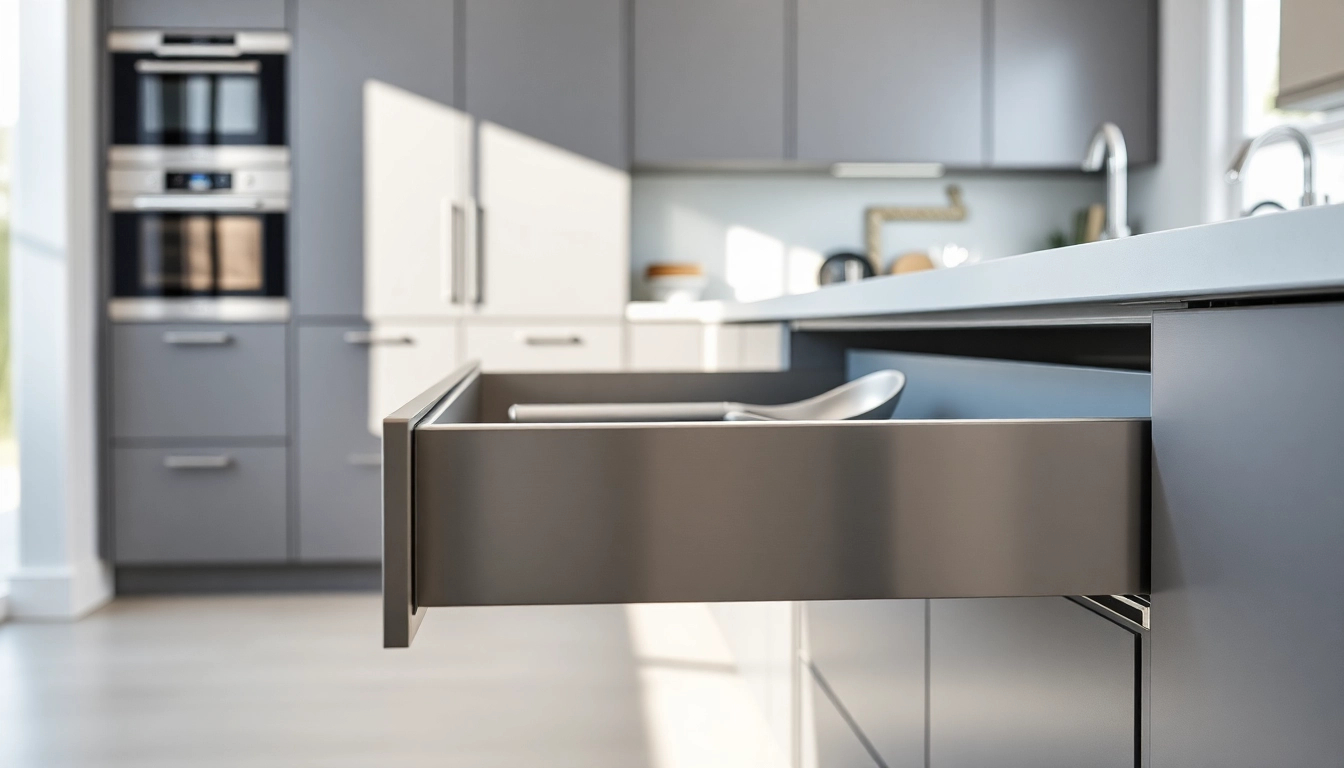Understanding the Metal Drawer System
What is a Metal Drawer System?
A Metal Drawer System is a sophisticated solution designed to offer enhanced functionality and durability in furniture. Unlike traditional wood drawer systems, metal drawer systems are characterized by their robust materials, typically constructed from high-quality steel or aluminum. They are engineered to support heavier loads and withstand daily wear and tear, making them ideal for various applications in residential and commercial settings.
At their core, metal drawer systems consist of several components, including side panels, bottom panels, and sliding mechanisms—often featuring ball-bearing systems that promote smooth operation. Their design is not only functional but also aesthetically pleasing, allowing for versatility in interior design.
Benefits of Using Metal Drawer Systems
The adoption of metal drawer systems brings a multitude of benefits for users, making them an appealing choice for many:
- Durability: Metal drawers are less prone to warping, cracking, or splitting compared to their wooden counterparts. This inherent strength ensures longevity, making them a valuable investment.
- Load Capacity: Metal drawer systems can handle significantly heavier loads, making them ideal for kitchens, workshops, and commercial applications. Many systems are designed to accommodate weights up to 100 pounds or more.
- Sleek Aesthetic: Metal drawers exude a modern, industrial look that complements contemporary design trends, from minimalist homes to urban lofts.
- Ease of Maintenance: Metal surfaces are typically easier to clean and maintain, resisting stains and odors often associated with wooden counterparts.
- Enhanced Functionality: Advanced features like soft-close and self-close mechanisms are more commonly integrated into metal systems, providing added convenience.
Popular Types of Metal Drawer Systems
Metal drawer systems come in various forms, each tailored for specific applications:
- Ball-bearing Slides: Featuring rolling elements, these slides ensure smooth operation and quiet closure.
- Under-mount Slides: Concealed beneath the drawer, these systems offer a clean aesthetic while also allowing for maximum drawer space.
- Pull-Out Bins: Ideal for kitchens and bathrooms, these systems allow for easy access to stored items, making organization effortless.
- Heavy-Duty Systems: Designed for industrial applications, these systems are built to withstand extreme use and heavy loads, often with reinforced materials.
Choosing the Right Metal Drawer System
Key Factors to Consider
When selecting a metal drawer system, several critical factors should be considered:
- Load Requirements: Assess the weight that your drawers need to support. For instance, kitchen drawers may accommodate heavier pots and pans, while office drawers may need to hold lighter files.
- Dimensions: Ensure that the drawer dimensions match the intended cavity. Measuring the available space is crucial for proper fitting.
- Slide Mechanisms: Choose between different sliding mechanisms. Ball-bearing slides offer smooth movement, while under-mount systems provide a sleek look.
- Finish and Style: The finish of the metal can enhance the aesthetic appeal. Options range from classic silver, brushed steel, to colored finishes for more modern designs.
Comparing Metal Drawer Systems
With numerous brands and styles in the market, comparing metal drawer systems can be daunting. Consider the following:
- Brand Reputation: Look for trusted brands known for their longevity and warranty. For example, companies like Blum and Häfele are renowned for quality.
- Customer Reviews: User testimonials can provide insights into real-world performance, durability, and installations from those who have used the products.
- Installation Requirements: Some systems may require professional installation, while others are DIY-friendly. Evaluate your ability and willingness to install the product yourself.
Where to Buy Metal Drawer Systems
Metal drawer systems can be purchased from various sources:
- Home Improvement Stores: Major retailers like Home Depot or Lowe’s often carry a range of metal drawer systems.
- Specialized Hardware Suppliers: Stores that specialize in cabinetry hardware or woodworking supplies are excellent for finding high-quality options.
- Online Retailers: Websites such as CabinetParts.com and Richelieu.com offer extensive selections and can often provide better deals than local stores.
Installation and Maintenance of Metal Drawer Systems
Step-by-Step Installation Guide
Proper installation is crucial to ensure functionality and longevity of your metal drawer system. Follow these steps:
- Gather Tools and Materials: You will typically need a level, drill, screws, a measuring tape, and the drawer system components.
- Measure and Mark: Determine the precise location for your drawer slides. Use a level and measuring tape to ensure accuracy.
- Install the Slides: Attach the drawer slides to the sides of the cabinet using the provided screws, ensuring they are level and securely fastened.
- Prepare the Drawer Box: Assemble the drawer box according to the manufacturer’s instructions, ensuring all components are aligned properly.
- Attach the Drawer to the Slides: Once the drawer box is ready, slide it into position on the installed slides, testing the operation to ensure smooth movement.
Common Maintenance Tips
Maintaining your metal drawer systems will prolong their lifespan:
- Regular Cleaning: Wipe down metal surfaces with a soft cloth and mild cleaner to remove dust and grime.
- Lubrication: Use a light lubricant on the ball-bearing mechanism once a year to ensure smooth operation.
- Inspect for Damage: Regularly check slides and drawers for signs of wear or damage. Replace parts as necessary before issues escalate.
Improving Durability of Your Metal Drawer System
Several practices can help enhance the durability of your metal drawer systems:
- Load Management: Avoid overloading your drawers beyond the specified weight capacity. This can help prevent breakdowns or failures.
- Proper Storage: Store heavier items near the bottom of the drawer to maintain balance and prevent tipping.
- Use Soft-Close Mechanisms: If available, opt for soft-close features to reduce wear and tear on the drawer slides.
Design Trends in Metal Drawer Systems
Modern Aesthetics and Functionality
Metal drawer systems are increasingly merging functionality with modern aesthetic needs. Designers are gravitating towards sleek, minimalistic forms that can blend with a variety of interior designs:
- Industrial Design: The raw, unfinished look of metal complements industrial chic environments, providing an edgy look.
- Sleek Lines: Contemporary designs favor clean lines and geometric shapes, enhancing the overall visual appeal.
- Color Options: Powder-coated finishes are becoming popular, allowing customization to match different themes.
Customizable Options for Metal Drawer Systems
The flexibility in design is one of the strong points of metal drawer systems:
- Modularity: Many metal drawer systems offer a modular approach, allowing customization according to specific space requirements.
- Color and Finish Choices: Consumers can select from a range of colors and finishes, adapting the appearance to varied decor styles.
- Added Features: Options like integrated lighting or smart technologies are increasingly being incorporated for further customization.
Integrating Technology with Metal Drawer Systems
Innovative technologies are becoming central to the evolution of metal drawer systems. Features to look out for include:
- Smart Sensors: Systems that incorporate smart technology can send alerts when drawers are overcapacity or require maintenance.
- Integrated Lighting: Some modern drawer systems come equipped with LED lights to illuminate contents as the drawer opens.
- Soft-Closing Technology: Enhancements in soft-close mechanisms add a touch of elegance and prevent slamming, increasing overall usability.
Frequently Asked Questions about Metal Drawer Systems
How to troubleshoot common issues?
Common issues include drawers sticking, failing to close properly, or damaging slides. Troubleshooting steps involve:
- Checking for blockage by objects within the drawer.
- Ensuring the drawer is not overloaded and that the weight distribution is balanced.
- Inspecting slides for damage or misalignment and adjusting or replacing as necessary.
Differences between metal and wood drawer systems
While both systems serve the same purpose, notable differences exist:
- Durability: Metal systems typically last longer and resist damage better than wood.
- Weight Capacity: Metal systems often handle heavier loads compared to wood.
- Maintenance: Metal is easier to clean and less prone to water damage than wood.
What maintenance is required for metal drawer systems?
Regular maintenance for metal drawer systems includes cleaning surfaces, lubricating moving parts, checking for alignment, and inspecting for any wear and tear. Addressing small issues early may prevent more significant repairs later.


